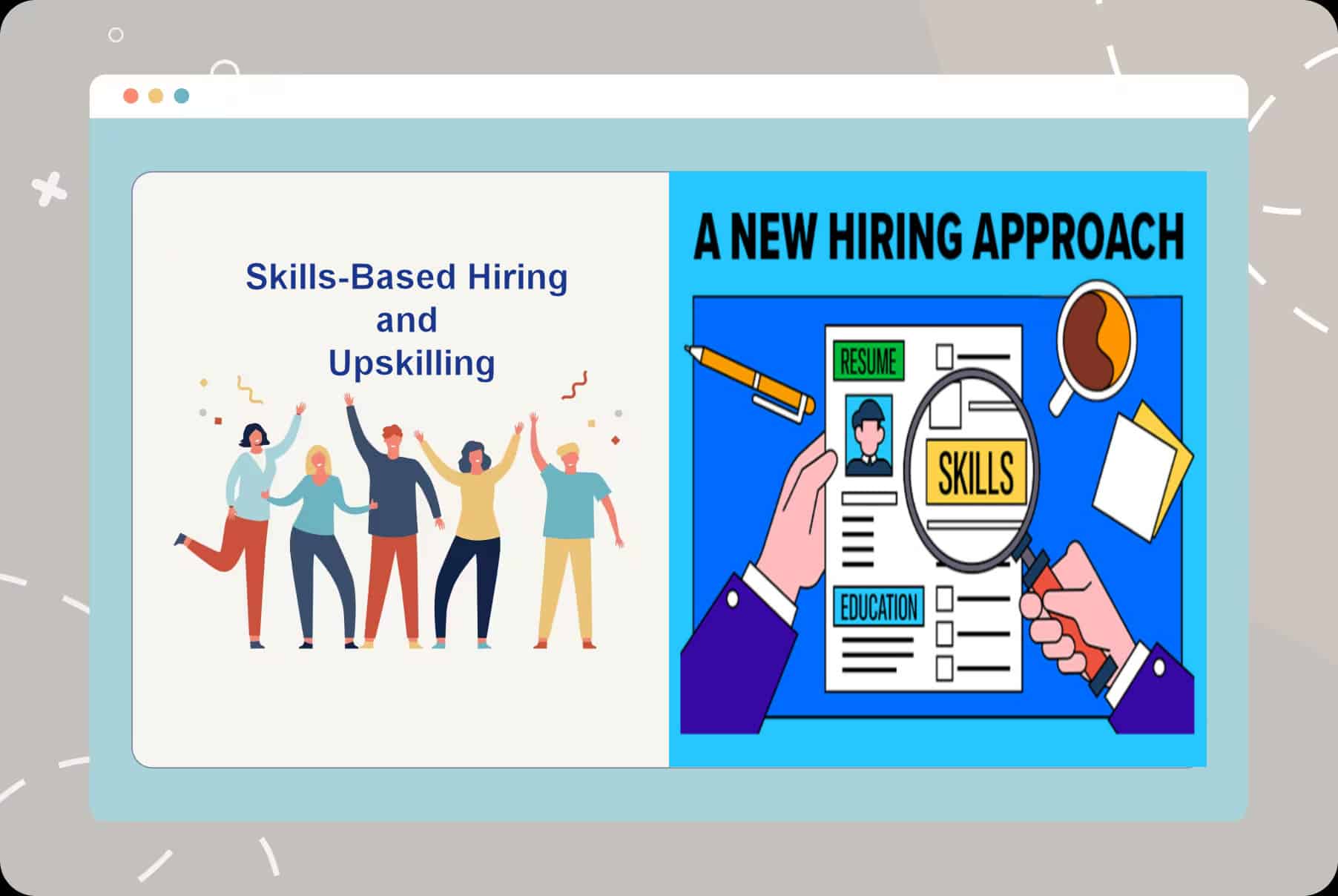The world of work is undergoing a profound transformation. The traditional use of four-year degrees as performance indicators no longer functions as the primary access point to career opportunities or work success.
Organizations now focus on skills-based hiring which assesses candidates through required competencies and supports continuous skill development to match evolving technological requirements.
El Adquisición de Talento process undergoes transformation through this movement which also establishes new methods for workforce development and deployment and retention of frontline staff.
This article investigates the reasons behind this transition while showing how employers construct skills ecosystems and AI plays an increasing part in identifying and provides actionable steps for creating a lasting skills development strategy.
Why Hiring Is Shifting from Credentials to Skills
The transition from credential-based hiring to skill-based recruitment practices has become necessary because of multiple organizational factors.
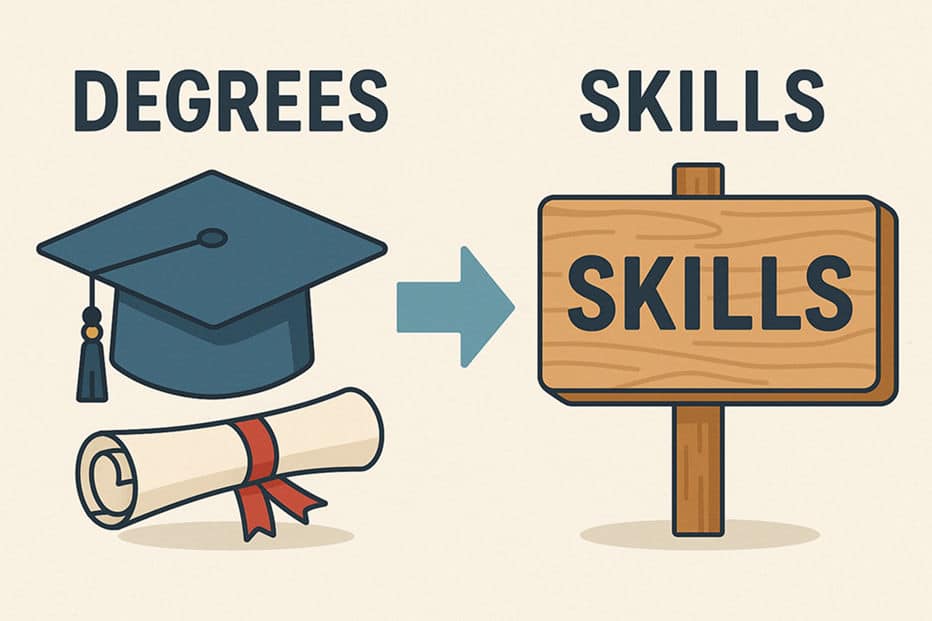
- The fast pace of technological advancement together with automation processes creates new tools that exceed the ability of educational institutions to update their teaching materials. Employers require workers who demonstrate fast learning abilities and adaptability instead of workers who hold fixed qualifications.
- The workforce faces ongoing skills shortages because job candidates frequently lack essential competencies such as data literacy and cloud fundamentals and cybersecurity basics and advanced customer support abilities.
- The elimination of degree requirements for non-essential positions enables employers to recruit candidates who bring diverse backgrounds including veterans and community college students and career switchers and bootcamp graduates. Organizations that focus on skills instead of education experience better hiring results and attract workers from different social groups.
- Research-based talent selection methods demonstrate better job performance prediction than traditional academic credentials do. Employers who use work samples and situational judgment tests and practical skill assessments achieve better hiring results.
What Skills-Based Hiring Looks Like in Practice
The implementation of skills-based hiring in real-world settings follows these specific guidelines.
Skills-based hiring requires more than simply rewriting job postings. The talent lifecycle requires organizations to implement connected practices for skills-based hiring.
- Define roles in terms of competencies: Each job position requires competency definition through specific skill sets and proficiency levels (e.g. “SQL: intermediate” and “customer de-escalation: advanced” and “inventory management: working knowledge”).).
- Replace unnecessary degree requirements: Organizations should maintain degree requirements only when they serve legal or practical purposes (e.g. clinical and licensure-based positions). The proceso de contratación should focus on essential skills and related competencies and relevant work history and practical experience.
- Use practical assessments and portfolios: The evaluation process should include work samples and coding challenges and structured interviews and job trials to assess candidates’ practical abilities.
- Hire for potential, not perfection: Organizations should select candidates who demonstrate learning potential instead of seeking perfect candidates because they can develop necessary skills through focused training programs.
- Monitor and iterate: The system should track which assessment methods and projects and credentials demonstrate the best connection to job success so hiring criteria can be modified accordingly.
Upskilling and Reskilling: The New Core of Workforce Strategy
The skills gap requires more than just hiring new employees to resolve it. The reduced time span for skill maintenance requires organizations to expand their candidate pool through skills-based hiring yet they still need to develop continuous learning systems. Organizations establish ongoing learning environments which include:
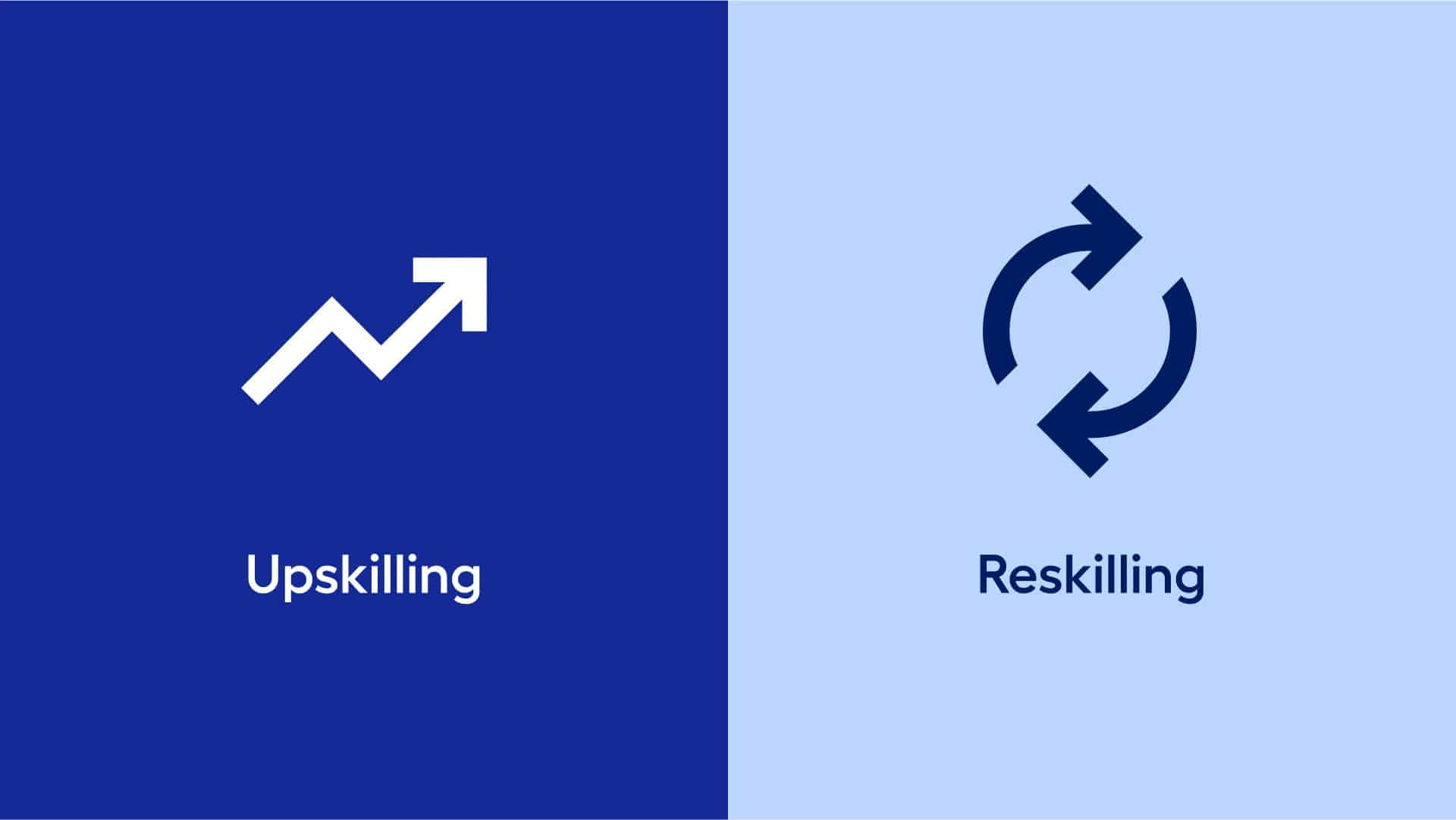
- Perfeccionamiento: The process of enhancing present staff members’ abilities within their current job responsibilities. The training of retail frontline staff to operate AI-based inventory management systems and predictive demand forecasting tools serves as an example.
- Reskilling: The process of training staff members to transition between different positions when business requirements shift. The training system enables customer service representatives to become data support analysts through structured educational programs.
- Microcredentials and stackable learning: The learning system provides microcredentials which are short competency-based courses that grant industry-recognized certificates which build up to complete qualifications.
- Earn-and-learn pathways: The earn-and-learn model combines paid work experience with skill development through apprenticeships and internships and on-the-job training programs. The models show exceptional success in developing frontline workers and entry-level staff.
Why Frontline Worker Training Is Surging
The core operations of organizations depend on frontline workers who include retail associates and warehouse teams and hospitality staff and field technicians and contact center agents. The investment in frontline worker development produces major benefits for organizations.
- Technology is moving to the edge: The edge of technology has become the new location for business operations because frontline teams now use daily AI-powered point-of-sale systems and automated replenishment and AR-assisted repairs and conversational AI tools. The training programs need to adapt to the tools that frontline workers use.
- Retention and mobility: The combination of advancement opportunities for frontline staff members between supervisor roles and trainer positions and data-enabled positions helps organizations maintain their workforce and decrease recruitment expenses.
- Safety and productivity: The combination of safety training with productivity education about new equipment and digital workflows results in fewer workplace incidents and better operational performance.
- Culture and brand trust: Organizations that spend money on frontline skill development create loyal employees and show genuine dedication to staff growth which strengthens their employer brand and customer satisfaction levels.
How Employers Are Building Frontline Learning Programs
Leading organizations create accessible training programs which deliver relevant content that produces measurable results for their frontline workers.
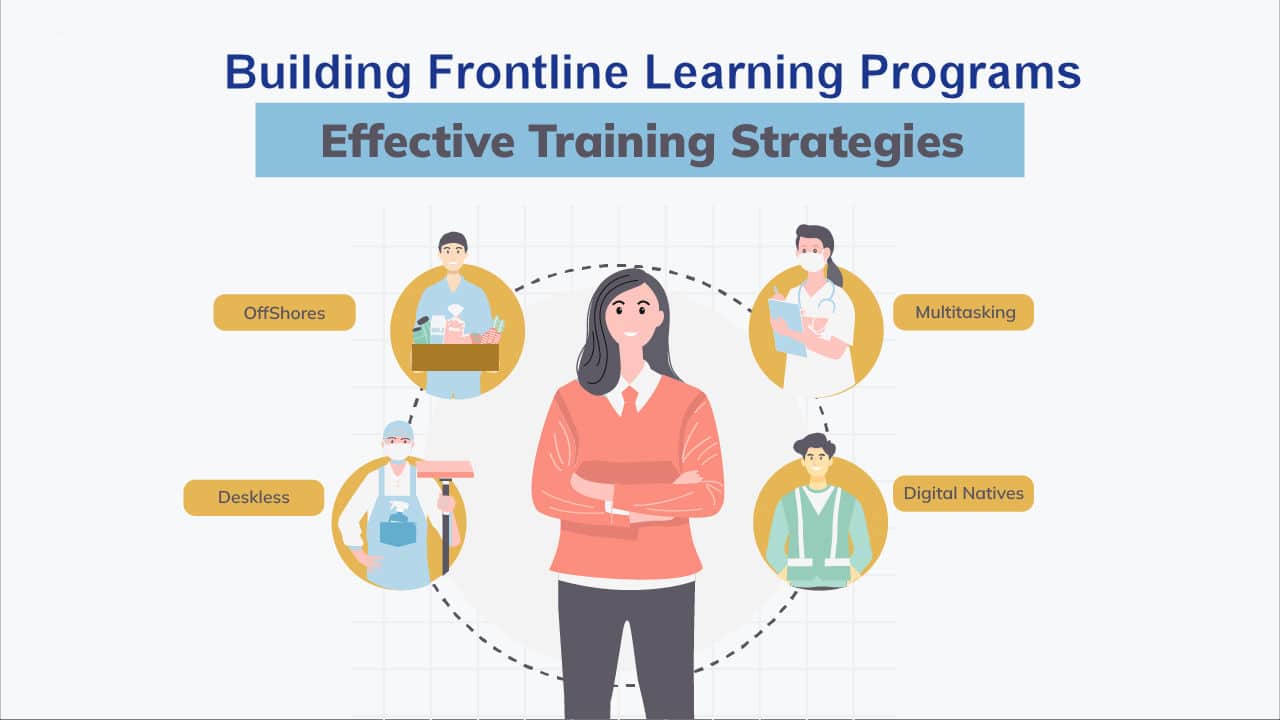
- Mobile-first learning: The learning system uses mobile devices to deliver short modules that match specific roles during work hours. The combination of short interactive content helps workers finish their training better while remembering what they learned.
- Contextual, just-in-time training: The system provides workers with contextual training at the right time through integrated work-based guidance which includes step-by-step AR instructions for equipment maintenance and chatbot assistance for handling difficult customer situations.
- Coaching and peer learning: The system combines digital content with on-the-job coaching and peer learning and community practice to help workers develop their skills.
- Clear pathways: The system provides employees with defined career progression paths that show how to move from frontline roles into positions like shift lead or operations analyst or safety coordinator or IT field support while specifying required competencies and credentials for each step.
The Role of AI in Identifying and Closing Talent Gaps
AI technology serves as a fundamental operational system which supports organizations to identify and resolve talent shortages.
AI systems under proper governance systems enhance both speed and operational efficiency during talent acquisition and development and employee movement processes.
- Skills inference and taxonomies: AI can analyze resumes, job descriptions, project histories, and learning records to infer a person’s skill profile and estimate proficiency. It normalizes disparate job titles and skill naming using standardized taxonomies.
- Labor market intelligence: Models can scan job postings and trend data to detect emerging skill demand in your industry and geography, helping you plan curricula and hiring ahead of demand.
- Internal talent marketplaces: The platform enables users to find suitable work assignments and mentorship opportunities and available positions through skill-based matching with their career goals and work availability. The system enables employees to move between roles more efficiently while shortening the time needed to find new positions.
- Personalized learning recommendations: AI recommends training based on role, current proficiency, aspirations, and performance data. It can also prompt managers when a small learning intervention would unlock a meaningful opportunity.
- Predictive workforce planning: The system uses predictive models to forecast skill deficits and generates recommendations for building internal talent or acquiring new staff or using external contractors.
- Quality and fairness checks: The system uses AI to identify biased hiring and promotion practices through quality checks and fairness assessments when properly monitored by auditors.
A Step-by-Step Guide to Implementing a Skills-First Strategy in Your Organization
The process of complete transformation requires no immediate action. The implementation process begins with a small-scale test before expanding to larger areas. Here’s a staged approach:
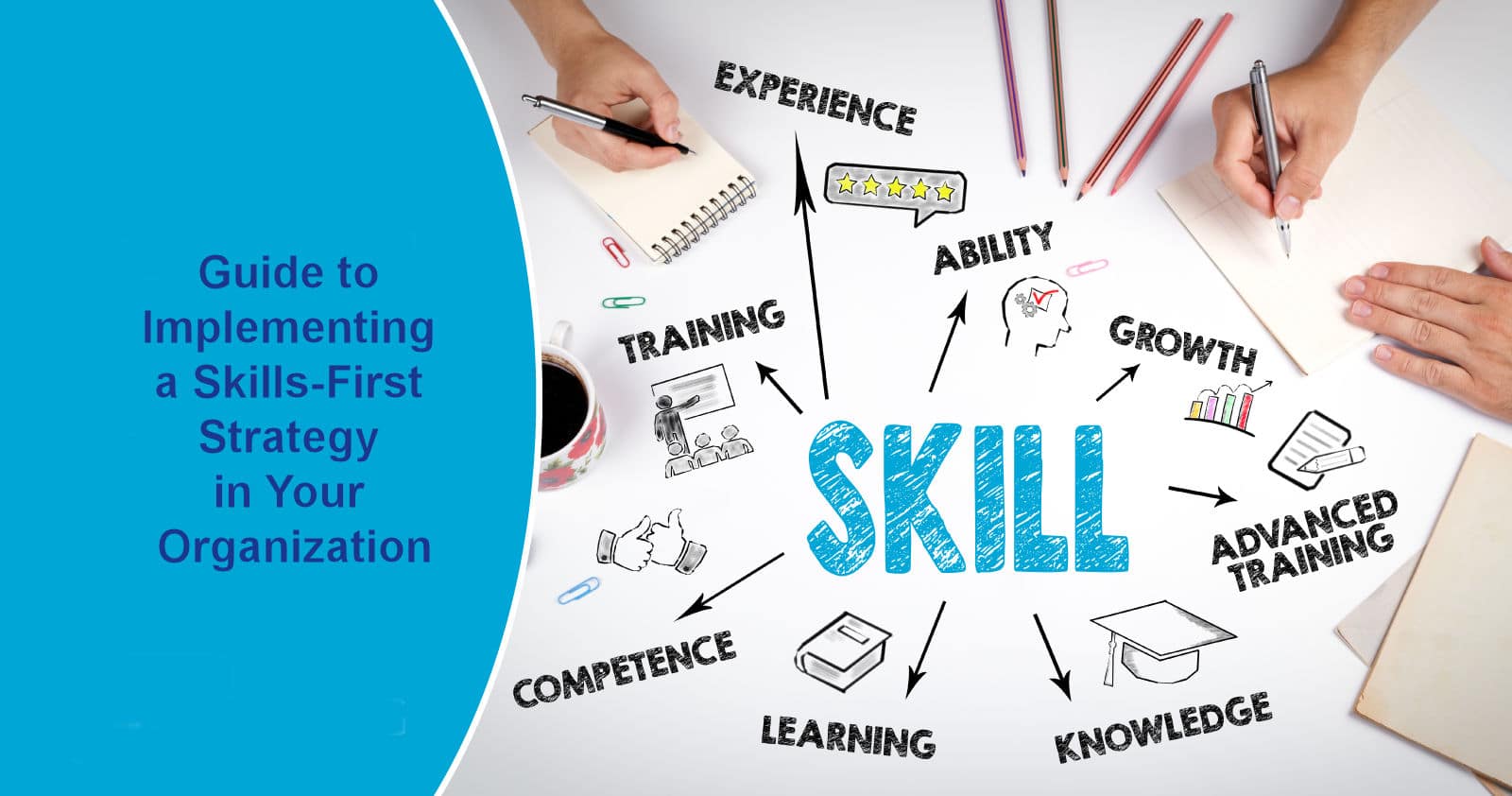
-
Align on business outcomes
- The organization should focus on essential areas were skill deficiencies block growth and quality improvement such as customer service and cloud engineering and maintenance roles.
- The organization needs to establish performance indicators before starting which include time-to-fill metrics and quality-of-hire standards and first-year retention rates and internal mobility percentages and productivity levels and customer satisfaction scores and training achievement and application metrics.
2. Build a skills framework
- The organization should develop or select a skills taxonomy system which defines core competencies and technical abilities and human skills for each role at different proficiency levels.
- The process requires hiring managers and top performers to verify essential skills while eliminating superfluous degree requirements.
3. Modernize job descriptions through competency-based assessments.
- Descripciones de trabajo need transformation to focus on required competencies and performance results instead of traditional educational requirements.
- The organization should implement job-specific assessment methods which combine work samples with rubric-based interviews to achieve better predictive results and minimize human bias.
4. Launch targeted upskilling/reskilling programs
- The organization should start by implementing training programs which deliver immediate business value through data literacy education for supervisors and AI-based customer service training and automation fundamentals for operational staff.
- The training program should use microlearning techniques with blended delivery methods which include self-paced modules and virtual labs and on-the-job practice and coaching sessions.
- The organization should provide recognized credentials to employees because these credentials help demonstrate the value of their skills.
5. Invest in frontline enablement
- The organization should provide paid training time to employees while making all content accessible through mobile devices and available in multiple languages.
- The organization should build transparent career paths between entry-level positions and higher-paying skilled roles by defining necessary qualifications and providing mentorship and financial support for education.
6. Deploy AI responsibly
- The organization should implement AI tools to perform skills assessment and internal talent marketplace management and learning suggestion generation.
- The organization needs to establish governance procedures which include documentation of input data and intended use and bias and impact assessments and human oversight for critical decisions.
- The protection of privacy requires organizations to reduce exposure of sensitive information while following all relevant privacy laws.
7. Measure, iterate, and scale
- The organization needs to monitor program and cohort performance through established metrics.
- The organization should evaluate skills-based hiring candidates against degree-based candidates through identical performance metrics.
- The organization should establish feedback systems which combine manager assessments with employee feedback and skill usage data from work activities and promotion advancement records.
- The organization should expand successful programs to new positions and work areas.
Common Pitfalls and How to Avoid Them
- Over-indexing on tools: Platforms are helpful, but without clear skills definitions, manager enablement, and incentives, adoption will lag. Start with governance and change management.
- Treating skills as a one-time project: Skills evolve. Assign ownership to maintain the taxonomy, update curricula, and refresh assessments as technology and strategy shift.
- Ignoring manager capability: Managers need training to interview for skills, coach effectively, and support development. Equip them with guides, rubrics, and time.
- Credential inflation in disguise: Replacing degrees with long lists of “required skills” can be just as exclusionary. Focus on true essentials, plus on-ramp training for the rest.
- Equity blind spots: If training and mobility opportunities are allocated informally, advantaged groups may benefit disproportionately. Use transparent criteria and track participation across demographics where lawful and appropriate.
Examples and Approaches That Work
- The combination of employer-funded certificate programs enables candidates without college degrees to prove their abilities through affordable and efficient certification paths for IT support and data analytics and cloud fundamentals and project management.
- The combination of paid learning programs with earning opportunities through returnships and apprenticeships leads to successful full-time job placements for career changers and returning workers.
- The implementation of internal talent marketplaces enables employees to gain new skills through short projects and gigs which maintains their current role and decreases recruitment expenses.
- The organization partners with educational providers including community colleges and workforce boards and nonprofits to develop local talent pipelines which offer essential support services like coaching and childcare benefits to frontline workers.
- The combination of tuition benefits with credential assistance through exam vouchers and materials support leads to higher employee participation rates. The employer provides reimbursement after completion of courses to help students stay motivated.
How AI Changes the Frontline Training Equation
- AI technology operates beyond traditional white-collar positions to deliver direct practical benefits for frontline workers.
- The system uses demand forecasting to detect training needs for station coverage which enables staff members to work across different stations while receiving additional working hours.
- The AI system delivers immediate guidance to staff members during customer interactions which enables new employees to learn faster and experienced staff to handle complex situations.
- The system uses computer vision and sensor data to detect safety risks and production irregularities while training programs receive updates for handling recurring problems.
- The system provides real-time language translation and multilingual educational content to enhance service delivery for diverse communities.
Measuring Impact: What to Track
A skills-first approach needs to show specific business advantages through measurable results. The following metrics provide useful data for evaluation purposes:
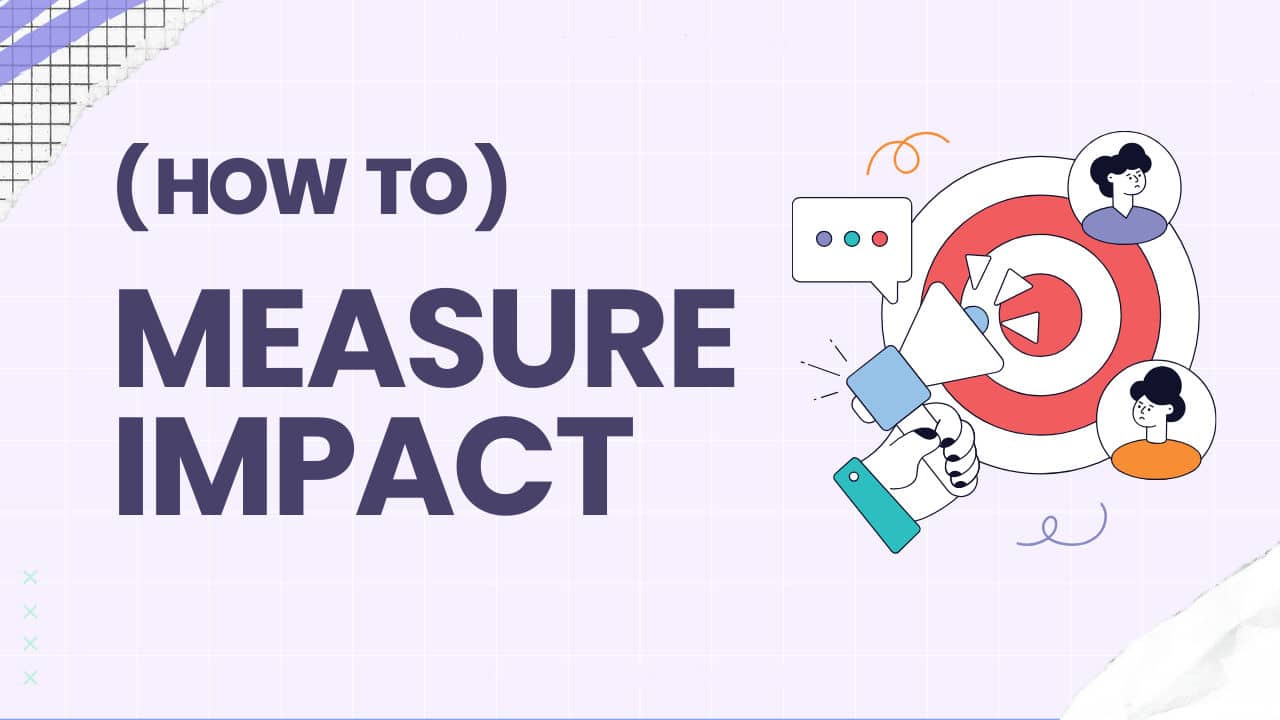
- The organization should track time needed to fill positions and the expenses related to hiring new staff members.
- The organization should track the quality of new hires and the duration needed for new employees to reach full performance.
- The organization should track first-year employee retention rates and their engagement levels.
- The organization should track how often employees move between departments and how often open positions get filled by internal candidates.
- The organization should track the percentage of job descriptions that use skills-based criteria.
- The system tracks employee participation in training programs and their completion rates and their ability to apply learned skills on the job.
- The system assesses employee skill development through pre-test and post-test evaluations.
- The organization should track diversity statistics for new hires and promotions when such data collection follows legal requirements.
- The organization should measure customer satisfaction and productivity growth through the evaluation of trained teams.
Conclusión:
The transition from degree-based hiring to skill-based hiring represents a strategic business approach which addresses the rapid changes in the modern economic environment.
Organizations that select candidates based on proven abilities and provide ongoing skill development and AI-driven talent discovery create adaptable workforces that deliver better results and inclusivity.
The transformation of work depends heavily on frontline personnel who perform essential tasks. Organizations that provide frontline teams with contemporary tools and structured learning paths through mobile training and coaching and credential recognition systems achieve better service quality and operational safety and maintain higher employee retention and develop stronger internal talent pools.
The process of beginning does not need a complete transformation of existing systems. Select a significant area to start with then identify essential competencies and test functional evaluations before creating a learning sequence that workers can finish while performing their duties.
AI systems should be deployed to enhance clarity and speed but organizations must implement governance structures and human oversight to maintain decision quality. The organization should track performance indicators while acquiring knowledge to expand its operations.
Organizations that succeed in an environment of continuous role and technology changes will be those which establish skills as the primary value for career advancement while making learning a collective duty that spans all organizational levels.


